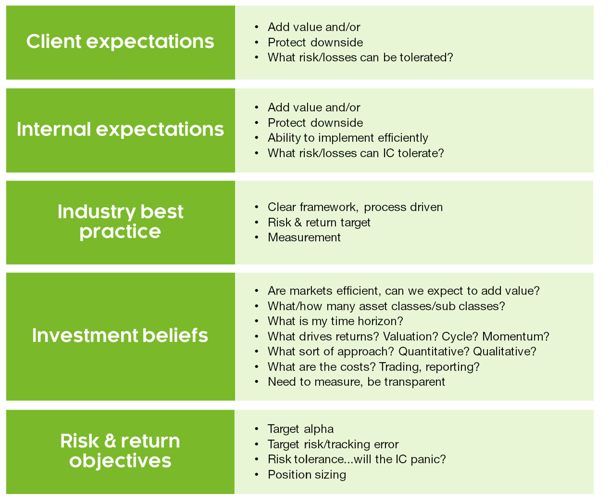Most investors understand the importance of asset allocation in generating portfolio returns and indeed some studies have suggested it accounts for 90 per cent of absolute returns. When considering the relative performance of funds, other studies have suggested that Strategic Asset Allocation can account for up to 1 per cent in absolute terms, or 40 per cent of the variability of returns compared to other funds. Active asset allocation (known as dynamic asset allocation or tactical asset allocation ) can add around 0.5 per cent in absolute terms, accounting for 20 per cent of the variability across funds. A further 30-40 per cent of the variability in returns can be explained by manager, stock, and style selection.
Beyond just being exposed to the capital markets, constructing a portfolio of diversified asset classes appropriate for the longer-term economic and investment regime or environment is perhaps the most significant part of active returns. Manager selection is also a significant contributor to the variability of returns, not only through the underlying manager’s skill, but also the manner in which manager selection contributes to the style, regional and sector exposures of the portfolio.
Investors want all areas working towards their portfolio objectives. My area of focus is on the DAA piece.
Why Dynamic Asset Allocation?
The terms dynamic asset allocation (DAA) and tactical asset allocation (TAA) are often used interchangeably. Many consider TAA to be very short term, focussed on mispricing of assets, while DAA is seen to operate over a 1 to3-year horizon and involves tilting a portfolio to, or away from, risk factors such as growth, inflation, and interest rates. Both represent deviations from a strategic asset allocation.
DAA seeks to generate alpha or reduce risk from an active top-down, global, and cross-asset perspective. DAA is used to make investment decisions across the major asset categories such as equities, bonds, cash, and currencies as well as within asset categories such as regions, countries, sectors, styles, credit, duration or market capitalisation. Whereas an SAA portfolio will be heavily influenced by valuation signals and longer-term themes or inflation or growth regimes, DAA decisions are largely informed by changes in the cycle, policy settings, relative value, and short-term mispricing. Valuations still play a role but sit alongside macro, earnings, policy and liquidity drivers.
The aim of DAA is twofold: return enhancement and risk mitigation. Return enhancement is achieved by positioning portfolios to benefit from a change in the cycle, or a change in the probabilities of certain outcomes regarding the cycle or policy settings. It can also seek to take advantage of relative value opportunities between two different assets, regions, currencies or styles. Risk mitigation may be achieved by responding to extremes in the underlying drivers of assets, for example, when ‘tight’ policy settings are coupled with extreme valuations.
What should a DAA program look like and what can it achieve?
The investment process needs to match a firm’s investment beliefs, client expectations and investment objectives. It then must form part of the investment policy so that it can be clearly understood, communicated, monitored, recorded and improved.

How to run a DAA program
Our DAA process incorporates six stages: idea generation, signal testing, signal development, interim portfolio tilts, qualitative overlay and final portfolio tilts.
A DAA process needs to have a framework that adds value/reduces risk, is consistent with investment beliefs, is repeatable, implementable, documents expectations and outcomes, is measurable, cost efficient, transparent and can evolve.
DAA is not a part-time pursuit. It involves constant monitoring and analysis of events, signals, data releases and announcements. By the same token, a DAA process must shield itself from the daily noise of highly opinionated or readily available ‘views’. Idea generation is ongoing, a process enabled by our StrategyEngine platform that allows for both quick, ad-hoc analysis of relationships through to more detailed signal testing and back-testing.
The signal testing and development components of the DAA process go some way to removing noise and bias but signals must be reviewed and evolved as markets and regimes change. In DAA you’re constantly asking “Is this signal still valid? or “Has some other non-data event overwhelmed the signal? “. It’s for this reason that signal performance must be measured over time, and that there’s a framework in which to identify ‘new’ or evolving signals. It’s also the reason why a qualitative input is required.
As for the more quantitative inputs, we use four broad categories: valuation, macro/earnings, policy/liquidity and momentum. As noted above, the valuation signals are already incorporated in the SAA long-term capital markets assumptions but enter the DAA world more as a risk factor. Our valuations signal will incorporate a range of different valuation models as we’re firmly of the belief that there’s no one model and that model uncertainty warrants a breadth of measures. As noted, valuation signals tend to operate best over a 3 to10-year time horizon and are typically negatively correlated with macro and momentum signals.
Our macro signals tend to operate over a 3 to12-month time horizon but are based on a combination of slow-moving indicators of business cycle phases together with shorter-term growth and earnings momentum measures. The policy and liquidity measures tend to work over a 3 to18-month time horizon, incorporating indicators such as cash rates, QE, excess liquidity and monetary conditions.
The four broad signals are used to build a composite indicator, or score, which then informs our initial DAA ‘tilts’. The stronger the signal, the larger the position indicated.
The qualitative input involves a few elements. We constantly evolve our most plausible scenarios for the upcoming 12 to18-month period and attach asset class return forecasts for each scenario as well as the probability for each alternative scenario. The scenarios allow us to incorporate non-data items such as geopolitical risks, and the risk that growth, inflation and policy outcomes are different to our base case scenario.
Overall, we generally require some good reasons to override our initial data driven signal.
Meet Damien Hennessy, Head of Asset Allocation
What do you like to do on your weekends?
After watching my daughter row at school, I thought that looks fun and “how hard can that be?”. Well for the past six years I’ve been rowing trying to learn the intricacies of a good stroke. Still not there!
During lockdown, given I was able to operate and provide our asset allocation service remotely, I spent a good chunk of time down the coast where my wife also operates a small hospitality business, and this is a place I enjoy visiting whenever I can.
And you support which AFL team?
I’m a devoted Geelong supporter and have been lucky to support a team that has had much success over the past 15 years. I love the strategy and tactics (and the data) of AFL.
What are you reading at the moment?
My family and I visited Sicily a couple of years ago and that inspired me to start reading “The Leopard”, a story of a dying aristocracy in Sicily, threatened by the forces of change, revolution, democracy and the political upheavals of Italy in the 1860s.
Best life lesson so far?
Things are never as bad as they seem nor as good as they appear. I think in life and in work there are times when you need to remember this!







